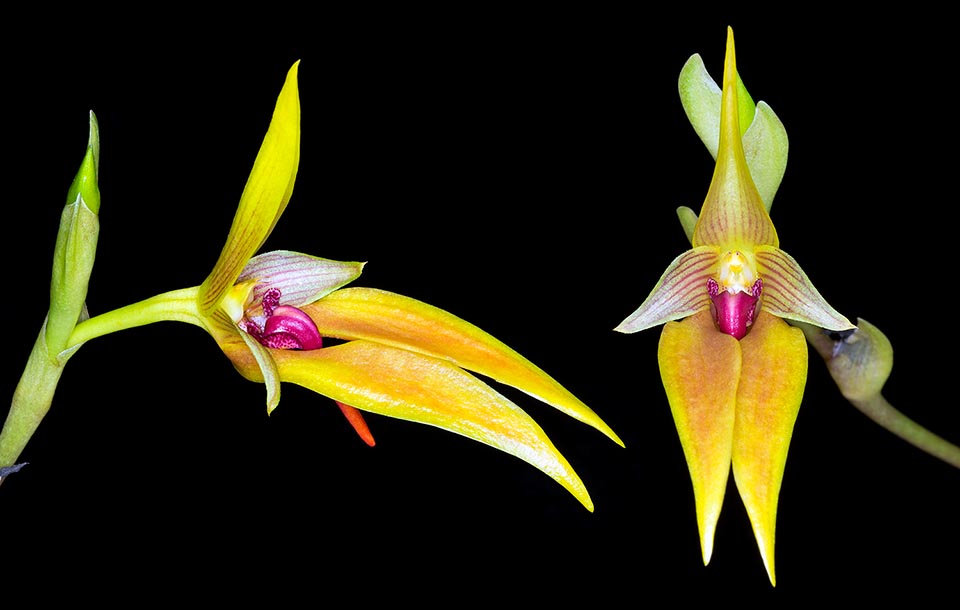Family : Orchidaceae

Text © Pietro Puccio

English translation by Mario Beltramini
The species is native to Philippines (Sarangani) and Sulawesi where it lives on the trees of the humid forests at low and medium altitudes.
The name of the genus is the combination of the Greek substantives “βολβός” (bolbos) = bulb and “φύλλον” (phyllon) = leaf, with reference to the leaves growing at the apex of the pseudobulbs. The specific name is the combination of the Latin adjectives “amplus, a, um” = ample, large, and “bracteatus, a, um” = provided of bracts, with obvious reference; the name of the subspecies is the combination of the Geek adjective “ὀρθός” (orthós) = straight, erect, and “γλῶσσα” (glossa) = tongue, with reference to the labellum.
The Bulbophyllum amplebracteatum subsp. orthoglossum (H.Wendl. & Kraenzl.) J.J.Verm. & P.O’Byrne (2011) is an epiphytic species, about 20 cm tall, with close ovoid pseudobulbs on a creeping rhizome rooting at the nodes and provided at the apex of only one oblong leaf with pointed apex, coriaceous, of intense green colour. Racemose inflorescence from the base of the pseudobulb, erect, on a 25-35 cm long scape of purple colour, with 10-12 flowers, 5-7,5 cm long and subtended by long triangular bracts, opening gradually, with yellow sepals and petals with thin brown-reddish streaks in the inner part and lively red, mobile, labellum. Lanceolate dorsal sepal with long pointed apex, about 4 cm long and 1,2 cm broad, ovate-lanceolate lateral sepals merged at the base with pointed apex, about 5 cm long and 1 cm broad, ovate petals with pointed apex, about 2,3 cm long and 1 cm broad, and 2-2,5 cm long labellum. The flowers are short lasting, but the blooming continues for several months, and emit a slight not really pleasant odour.

Native to the humid forests of Philippines and Sulawesi, the Bulbophyllum amplebracteatum subsp. orthoglossum is an epiphytic, about 20 cm tall species. Racemose inflorescence with 10-12 ephemeral odourous flowers, 5-7,5 cm long, opening gradually, with yellow sepals and petals ans lively red, mobile, labellum © Giuseppe Mazza
It reproduces by seed, in vitro, and by division, with each section provided of at least 3-4 pseudobulbs.
Species among the most appreciated of the genus, requires a semi-shaded position, medium-high temperatures, 22-30 °C, in summer, slightly cooler in winter, with lowest night ones not under the 15 °C, high humidity, 75-85%, and a good air circulation. The waterings and the nebulizations must be regular during the growth period, but avoiding stagnations, more spaced in winter, allowing the substratum to dry up partially, utilizing rain water, demineralized or by reverse osmosis. Fertilizations every two weeks from spring to autumn utilizing a hydrosoluble balanced product, with microelements, at ¼ of the dosage shown on the package. It can be mounted on trunks, bark or rafts of arborescent frens roots with some sphagnum at the base of the plant, or placed in pots or rather low baskets with particularly aerated and draining substratum that may be formed by medium sized bark fragments with addition of charcoal and possibly sphagnum, to maintain a greater humidity, if the ambient is quite dry. The repottings are to be done when strictly necessary, disturbing the least possible the roots, at the vegetative restart.
The species is reported in the appendix II of CITES (species whose trade is internationally ruled).
Synonyms: Bulbophyllum orthoglossum H.Wendl. & Kraenzl. (1896).
